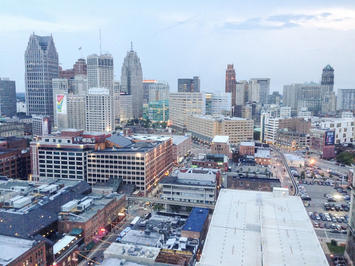
So it seems the debate has begun. There's been enough progress in Detroit to discuss whether its rebound is for real, or not.
Two academics, Laura Reese of Michigan State University and Gary Sands of Wayne State University, wrote a piece for the Atlantic a couple weeks ago to counter the spreading narrative of Detroit's comeback. The article notes the Motor City's rebound has caught the attention of the national media and parts of academia, but they aren't so certain that the trend is real, or if it is, whether it's indeed sustainable. From the article:
"These rosy descriptions were not consistent with the reality of what we continued to see in many Detroit neighborhoods. To provide perspective on Detroit’s comeback story, we examined trends in a variety of indicators including population, poverty, income disparities, business recovery, unemployment, residential sales prices and vacancies, and crime.
Two major conclusions emerged from our data. First, by a number of measures Detroit continues to decline, and even when positive change has occurred, growth has been much less robust than many narratives would suggest. Second, within the city recovery has been highly uneven, resulting in increasing inequality."
In response to this article, blogger Lyman Stone added his take on Detroit's recovery. He seems to agree with Reese and Sands that, whatever is happening in Detroit, it's not touching growing numbers of city residents, and therefore it's not exactly a comeback:
"I tend to be on team “Abandon all hope ye who enter here.” Saving Detroit is likely to be extremely costly while still holding a high risk of failure, in my opinion. But this view is predicated on a certain perspective of what it means to succeed. To some, success means population decline stops. To some, success means fewer empty buildings. To some, success means balanced municipal finances. To some, success means increasing employment. To me, I tend to think success means that huge population outflows will stop, and that population will begin to rise. Others may espouse other views, but I tend to think a locality’s ability to provide prosperity only matters in a general equilibrium framework, so a place that makes locals rich by culling the herd of non-rich locals is not “succeeding.” Success means that you offer prosperity to a rising share of the general population."
However, Stone notes that there are some positive demographic trends that are evident in Detroit, and seems to make the case that if Detroit is to get out of its hole, it's at least stopping digging.
The City Observatory's Joe Cortright took a positive spin on Detroit in the Atlantic, going against the grain of both pieces and suggesting that Detroit's comeback shouldn't be dismissed:
"Is Detroit “back?” As best I can tell, no one’s making that argument. The likelihood that the city will restore the industrial heyday of the U.S. auto industry, replete with a profitable oligopoly and powerful unions that negotiate high wages for modestly skilled work, just isn’t in the cards...
That said, there’s clear evidence that Detroit has stanched the economic hemorrhage. After a decade of year-over-year job losses, Wayne County has chalked up five consecutive years of year-over-year job growth. True, the county is still down more than 150,000 jobs from its peak, but it has gained back 50,000 jobs in the past five years."
Honestly, I think each of the pieces -- indeed, most people -- underestimate the depths of Detroit's collapse, and therefore underestimate the significance of its current recovery. Detroit's collapse was not simply an economic one, but a cultural, social and demographic one as well. It lost virtually all connections with the networks of wealth and information that drive economic growth, and the city had such a pervasive negative perception that it was effectively erased from the minds of many. What's happening now is Detroit is reconnecting itself to the national and international network of cities, slowly returning to life among the living. This is a necessary step for Detroit before any rebound that improves the lives of the majority its residents.
I view things this way. While Detroit suffered immensely from the restructuring and decline of the auto industry, it likely suffered even more from demographic collapse. Four years ago, I wrote a piece that showed the strength of the city's demographic vacuum. It's not just that the city lost jobs and people moved. People soured on Detroit in ways no other major city experienced, and left behind a city of concentrated poverty. I've often brought this graphic out, and it still amazes me:

To his credit, Joe Cortright gets this in his article. Where Reese and Sands argue that Detroit's economic boost in the downtown and Midtown areas and some select nearby neighborhoods is raising income inequality, Cortright responds with a comment from the Brooking Institution's Alan Berube: "Detroit does not have an income inequality problem—it has a poverty problem. It’s hard to imagine that the city will do better over time without more high-income individuals."
And that's indeed the critical first step for Detroit. It has to once again attract a critical mass of middle income and upper income residents who are ready, willing and able to invest in the city, before it can effectively take on its greater economic challenges. The post Great Recession recovery we're witnessing now means the city is getting closer to being able to take on greater tasks.
Pete Saunders is a Detroit native who has worked as a public and private sector urban planner in the Chicago area for more than twenty years. He is also the author of "The Corner Side Yard," an urban planning blog that focuses on the redevelopment and revitalization of Rust Belt cities.
Top photo source tomabouttown.wordpress.com












